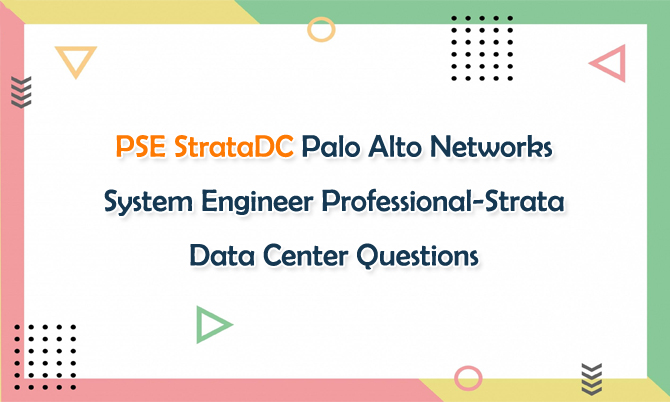PSE StrataDC Palo Alto Networks System Engineer Professional-Strata Data Center questions are available, which can guarantee you success in the first attempt. All of Palo Alto Networks PSE StrataDC exam questions are collected by top certified experts, who have years of experience on training PSE StrataDC candidates. The Strata QuickStart services are matched with your technology capabilities to provide right-sized solutions to meet your business needs, provide confidence, and reduce the strain on your staff to perform the optimal implementation and capability optimization.
Study the related Palo Alto Networks PSE StrataDC exam information can help you have a basic understanding of the test. Palo Alto Networks has coupled the unparalleled automation capabilities of Panorama with ServiceNow to deliver the benefits of selfservice security policy management. Strata is the industry-leading network security suite, which prevents attacks and manage network transformation while consistently securing users, applications, and data, wherever they reside.
Palo Alto Networks PSE StrataDC real exam questions contain 60 Q&As, which can help you test all the related topics. Share some Palo Alto Networks System Engineer Professional-Strata Data Center PSE StrataDC real exam questions and answers below.
1.A network administrator is working on a VMware NSX installation with VM-1000-HV firewalls The administrator has created a security group that is populated with VMs The administrator is trying to create a Dynamic Address Group in Panorama, but the security group is not showing. Which task should the administrator perform first?
A. Go into vCenter/NSX and push the objects to Panorama
B. Delete and re-add the security group.
C. Go into Panorama and synchronize the Address objects with NSX
D. Check the NSX Security policy to ensure the security group has been used in a policy.
Answer: D
2.In which two ways can micro-segmentation save money for the enterprise? (Choose two.)
A. fewer capital expenses because fewer physical servers need to be bought
B. fewer operating expenses because a smaller data center is operated
C. fewer operating expenses because less public cloud capacity needs to be rented
D. fewer capital expenses because the same number of physical servers can be kept in a smaller space
Answer: A,C
3.For which two reasons would an administrator have to install NGFW automatically in a cloud environment? {Choose two)
A. reduce capital expenses
B. performance, to be able to install a new firewall when the demand exceeds the ability of the existing environments to service
C. integrity, to ensure that data is not changed illicitly
D. resiliency and availability, to be able to install a new firewall as part of a new environment if an existing environment fails
E. security, to automatically install a firewall when a security threat is detected
Answer: B,E
4.A customer wants to completely segment their internal networks They have Cisco switches and extensively use 10Gbps interfaces. They are running VMware ESXi and are considering implementing NSX. Which three Palo Alto Networks firewall models will support this deployment? (Choose three.)
A. PA-3050
B. VM-100
C. VM-300
D. PA-3250
E. PA-7050
Answer: A,D,E
5.Which option describes Arista's micro-segmentation?
A. Arista and VMware are extending secure segmentation with an open API (RESTZJSON)-based exchange, which allows NSX to federate with CloudVision to extend the micro-segmentation policy for physical workloads.
B. Arista and Kubernetes are extending secure segmentation with an open API (RESTVJSON)-based exchange, which allows Kubernetes to federate with CloudVision to extend the micro-segmentation policy for physical workloads.
C. Arista's micro-segmentation and macro-segmentation are identical concepts that can be used interchangeably
D. Arista and VMware both perform identical functions for NGFW micro-segmentation
Answer: B
